October 18, 1924
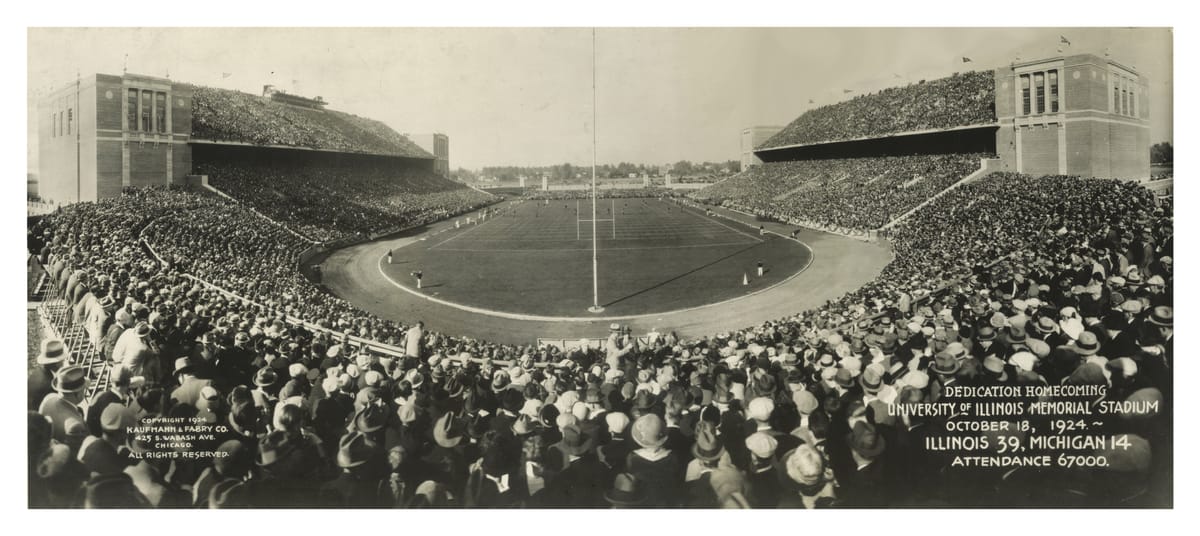
First the Robert story, then the article.
I knew I wanted to write about the 1924 game this week. And I knew that there was a photo of the game near the elevators on the 8th floor of the Memorial Stadium tower. So after Bret Bielema's press conference on Monday, I asked if it was OK if I went down to the center elevator lobby and took a picture of the picture. (I'm not sure I really even needed to ask. The press conference is on the 8th floor and all I had to do was open one door to get to that elevator lobby. But... I'm a rule follower so I wanted to ask if I could go through that door.)
The photo is right here between two elevators:
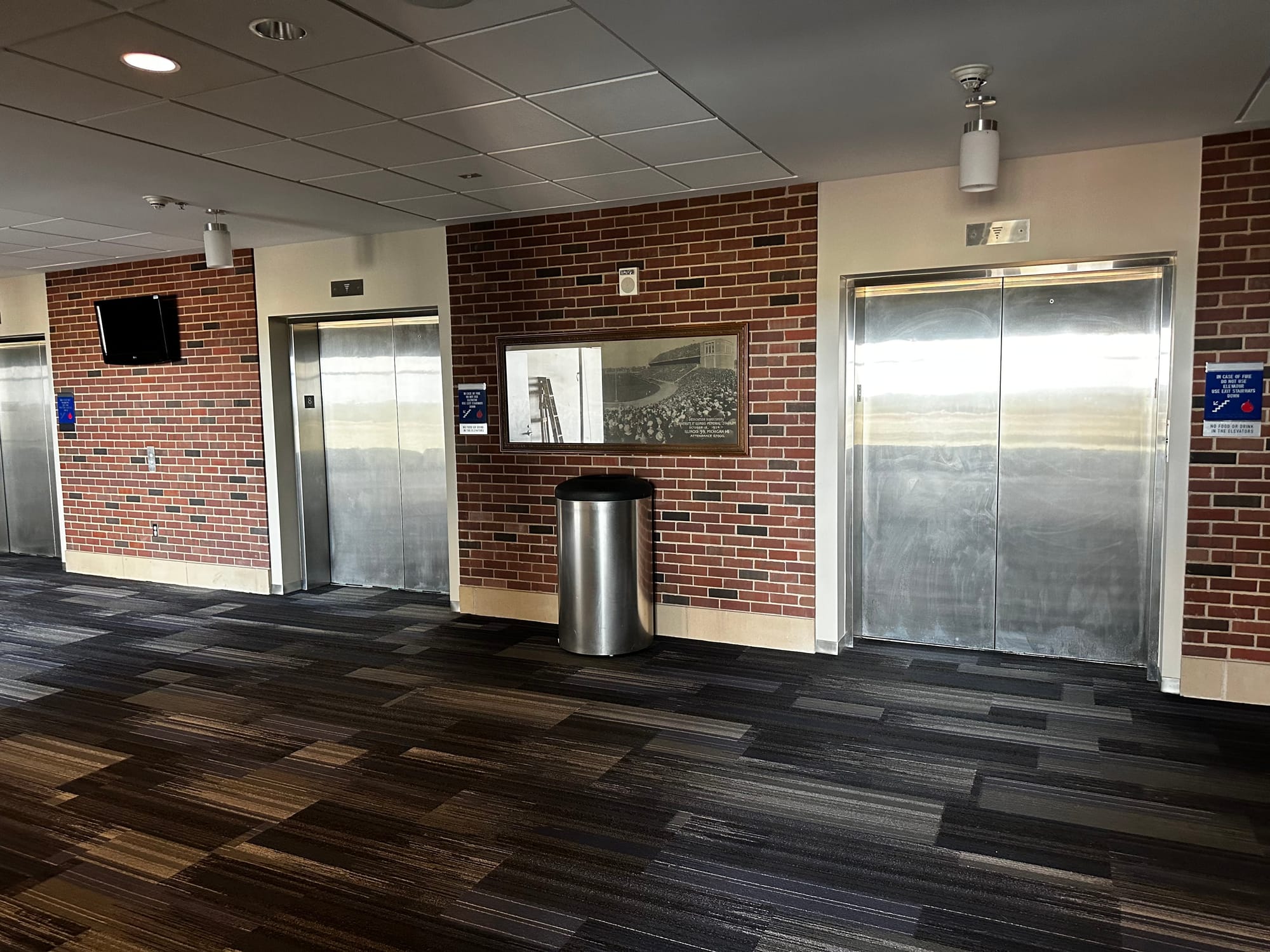
Those elevators are the access point for the radio crews, TV crews, the Athletic Director's Suite, and the President's Suite. I haven't been down there very often, but I do remember seeing that photograph of October 18, 1924. So I wanted a photo-of-the-photo for this article.
I tried taking one straight on. Nope. You could see me standing there:
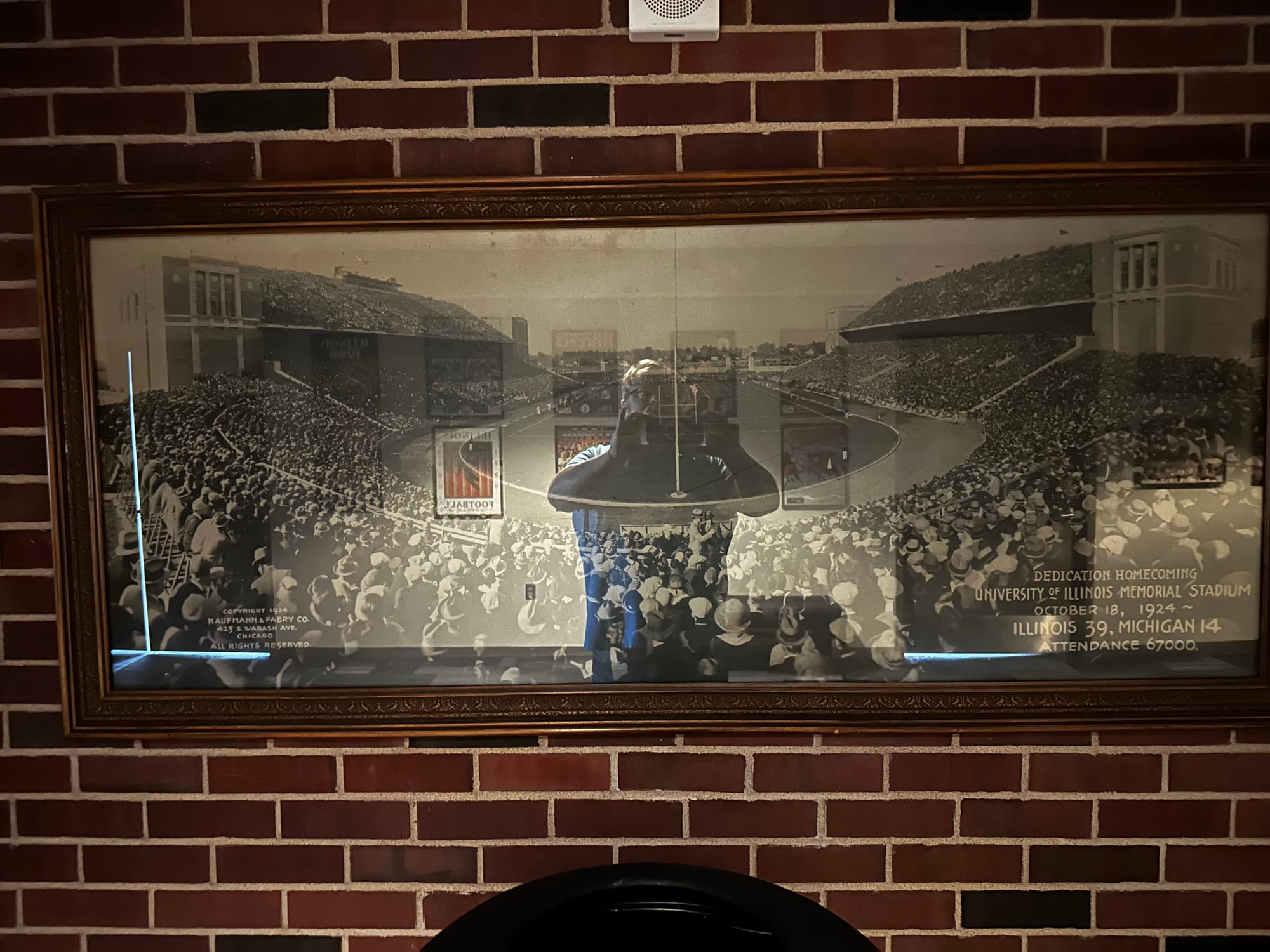
Maybe if I stand off to the side you could see the photo? Nope.
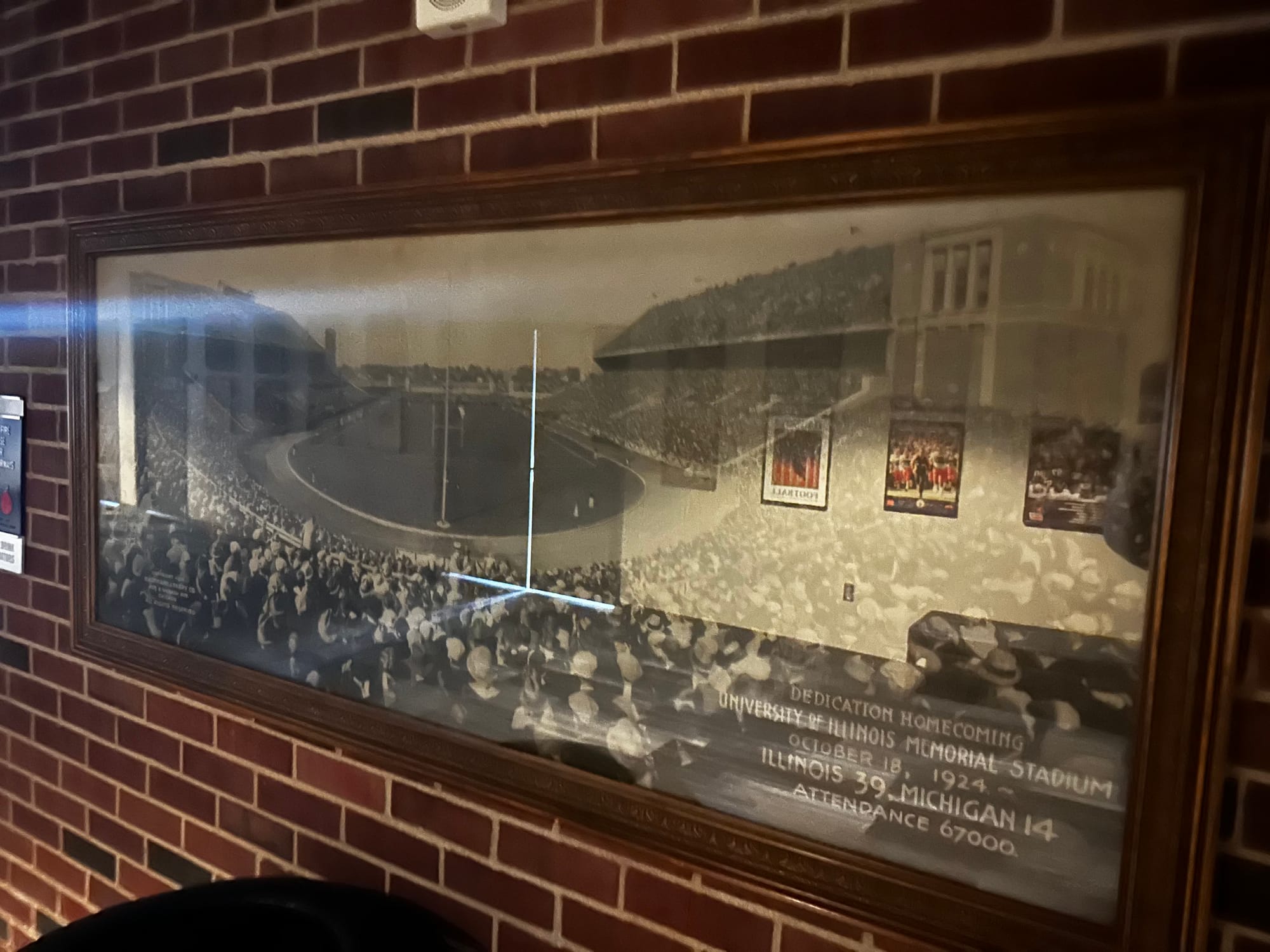
I went back down to the press box to ask permission to take the photo off the wall. I received said permission. I took the photo off the wall and took it into the TV broadcast room:

It's not set up right now, but that's where Brad Nessler and Gary Danielson will be set up on Saturday. For a national broadcast like that I'm sure they'll set up backdrops, monitors - everything you see on the broadcast. But on a Monday afternoon, it's just a room with a few tables and chairs.
I used one of the tables to lay the 1924 photo flat. Then I held my phone above it and tried to take a photo. Nope. Gotta turn those lights off.
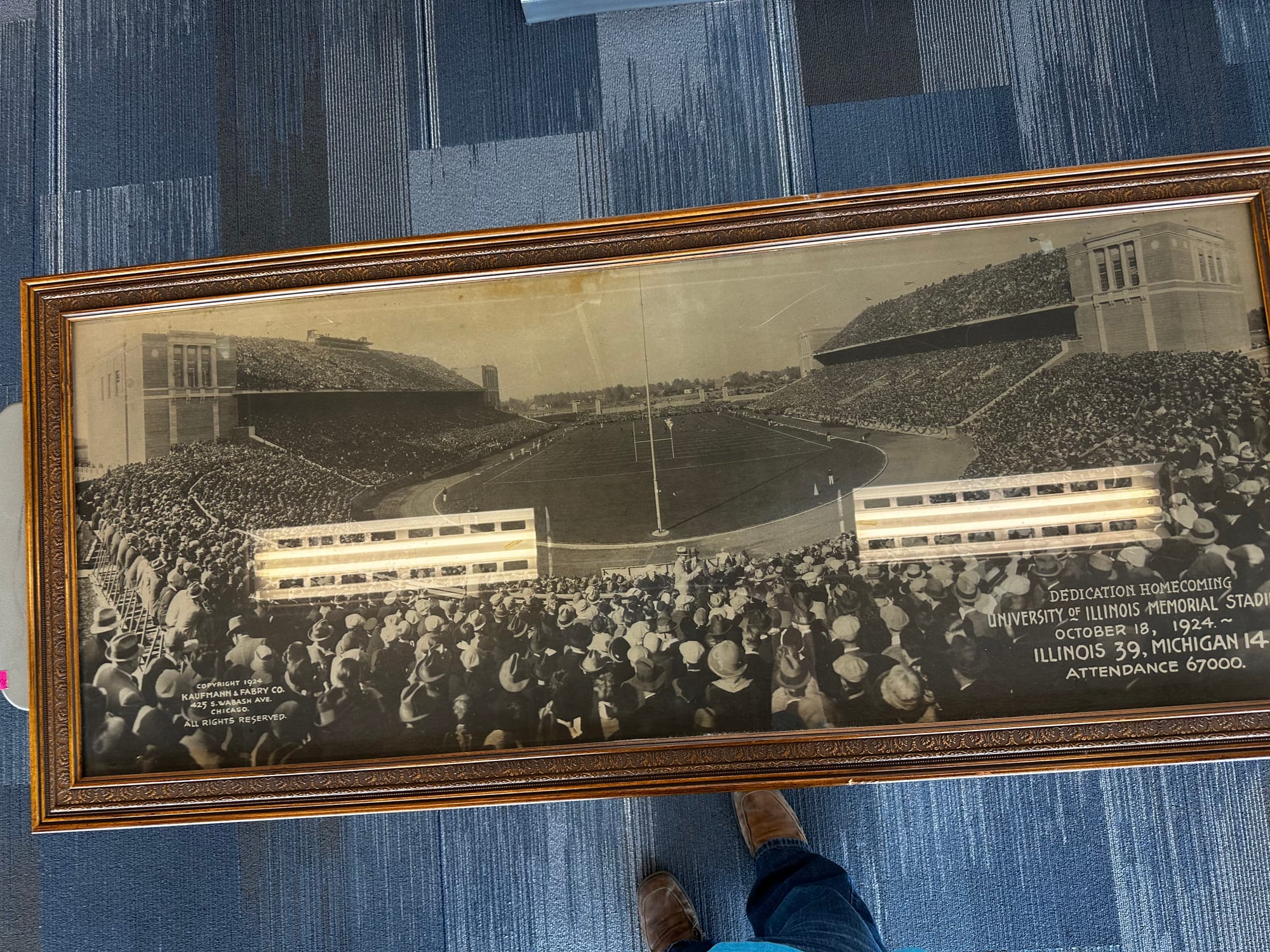
After I turned the lights off I decided that I needed to get further from the photo so I stood on a chair and took a pic from well above the photo. It kind of worked. Here's what I got:
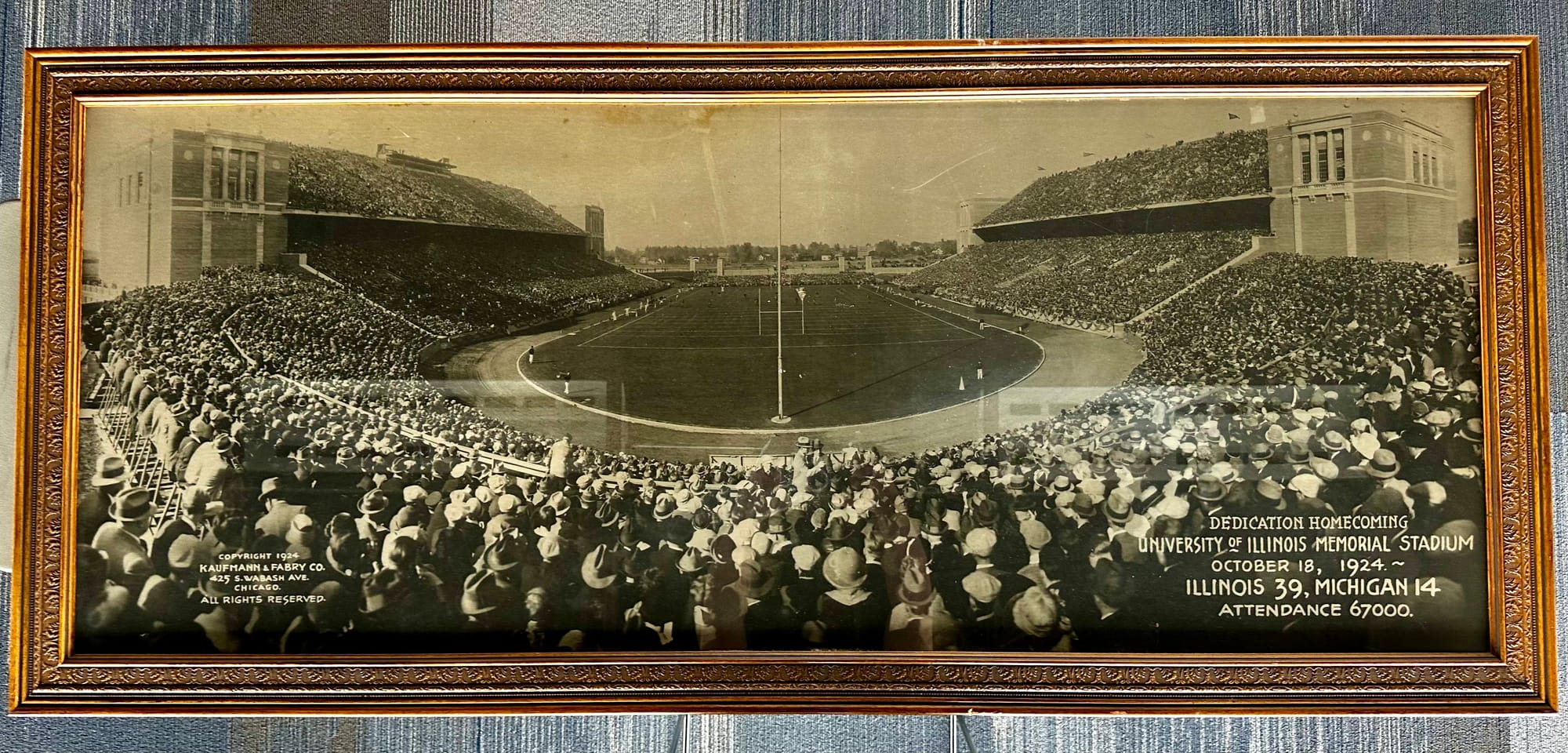
You can still see the lights above but whatever. Close enough. I have a photo I can use.
I then retrace my steps. I put the TV broadcast room back together by putting the table and the chair back where I found them. I had to enlist the help of one of the SIDs to make sure I hung the photo properly and the wire hanger caught both screws on the wall. If lights were on when I got down there, I turned them back on. If doors were open, I re-opened them. Leave no trace, folks.
I then went back down to the pressbox and told DB that I had gotten the photo I needed. And he reminded me that Brett Moore had placed a bunch of 100th Anniversary photos in a Box folder that the media has access to. Care to guess what high-resolution photo was in that folder?
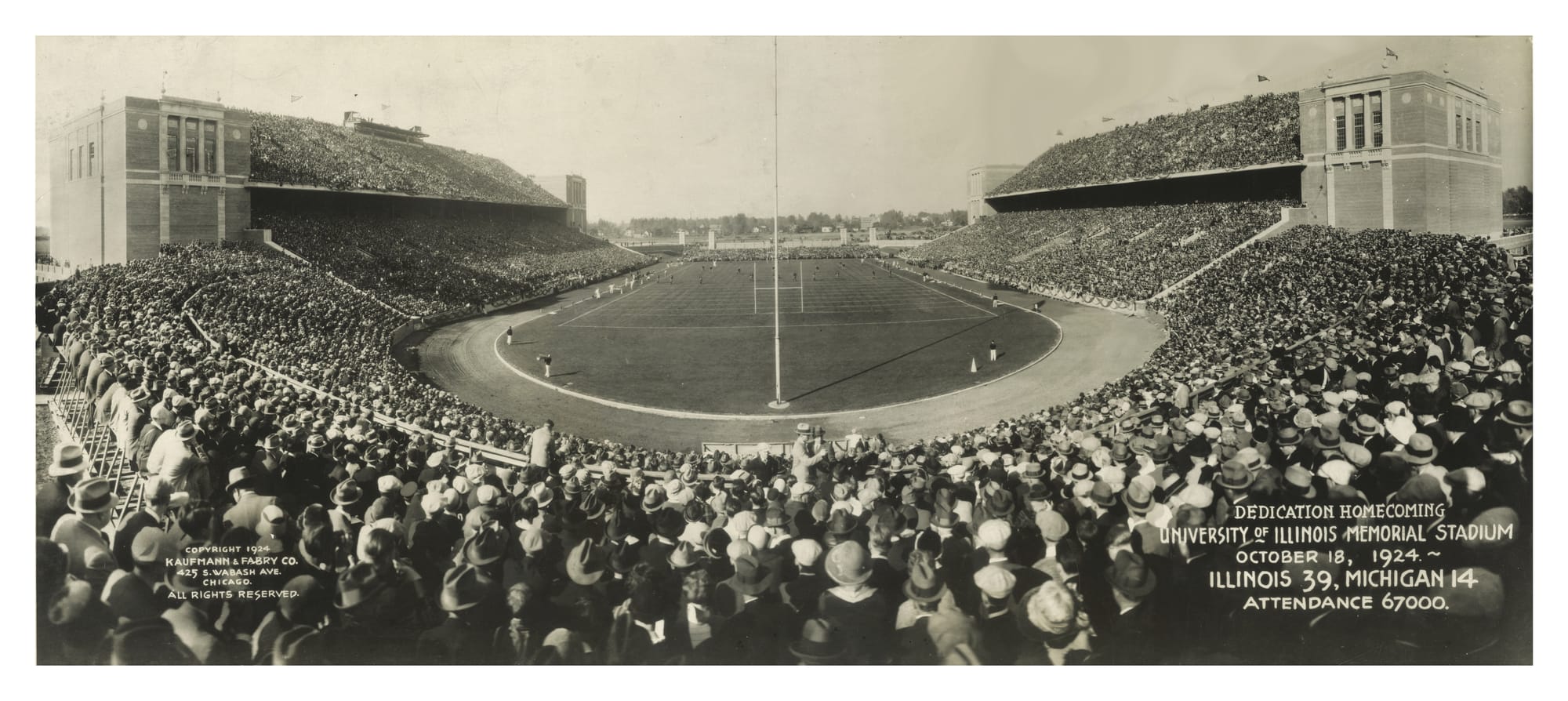
Forty minutes taking a photo of a photo that I already had sitting in an online folder waiting for me. A folder I had flipped through only a few weeks ago. This... is my life.
Here's my plan with this article. Detlef will have a Those Were The Days tomorrow and it will discuss the game. The who and the what and the how. I want to discuss the when and the why. Why is this game such a big deal?
Before we get started, I also want to note that there's a seminar (symposium) tonight (Thursday night) at 6:30 pm CDT. You can attend for free inside the 77 Club at the stadium or you can watch it online here. That discussion will have approximately 93 times more information than this article. I don't want to pretend like I'm some historian here. I just want to talk about this game – like I talk about everything else – from the Illini fan angle.
When I talk about October 18, 1924 on Twitter, I get responses like this:
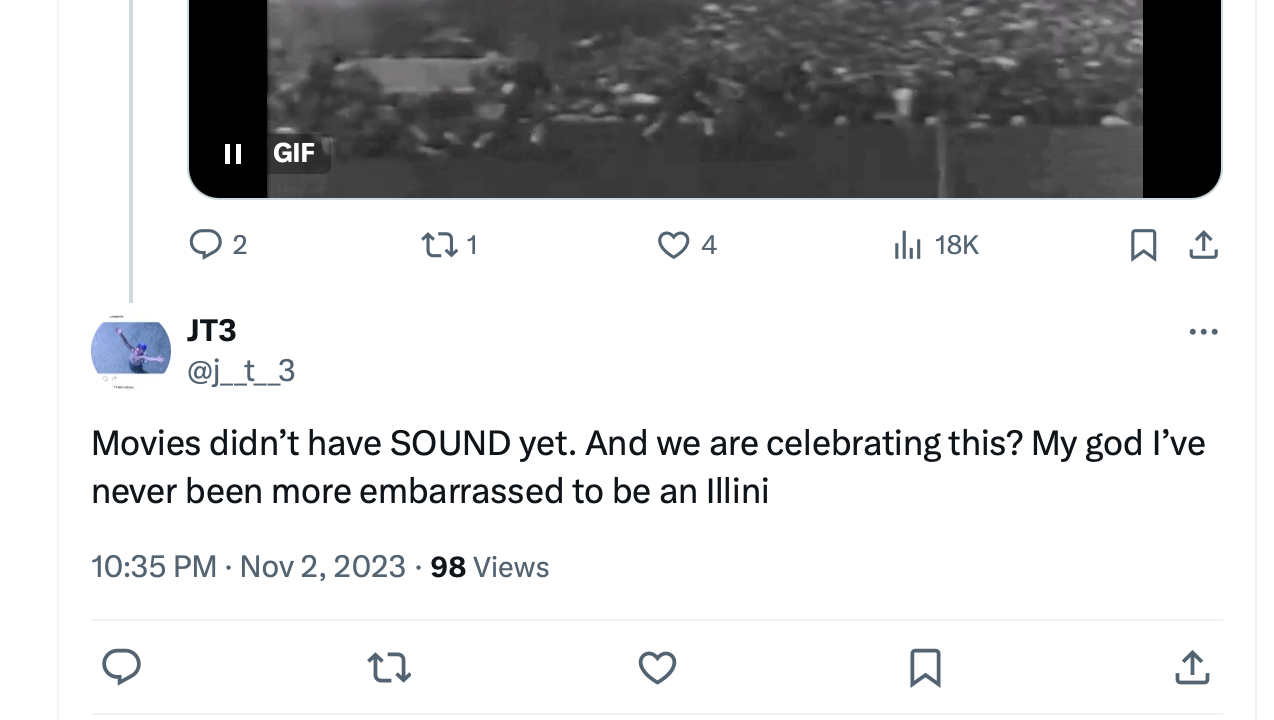
So I want to address it. Why am I so obsessed with one football game 100 years ago? Why did I go on Twitter 2+ years ago and campaign for a theoretical Michigan game to be played on October 19, 2024?
I guess I probably should put that out there, too. We talked about this on Slack recently but maybe I should toot toot here as well. Did you know that this game on Saturday... was my idea?
I guess I can't say for certain. But I know. Here's how it went down.
On June 30, 2022, it was announced that USC and UCLA would be joining the Big Ten. That always triggers my brain to say "well, the entire Big Ten schedule for the next four years will now have to be completely re-done." And if the schedule is being re-done, that means that there's a chance Michigan could come back on our 2024 schedule. And if that happens, there's a 50/50 shot of the game being in Champaign. And if THAT happens, there's a tiny chance that we could celebrate the 100-year anniversary of The Red Grange Game with a home game against Michigan.
So I put that out there on Twitter on July 6th of 2022:
With UCLA & USC joining in 2024, that season will be the first year of a new B1G schedule rotation. If it's 3-6-6 (3 teams on a yearly rotation plus 6 one year and the other 6 the following year), I want to see Michigan in Champaign on 10-19-24. 100 years and 1 day after... pic.twitter.com/iUuSy0KN1V
— Robert Rosenthal (@ALionEye) July 6, 2022
That was then amplified by Coach Bielema when he quote-tweeted it three minutes later:
Great fun fact #ILL https://t.co/5lZ9gmDeFI
— Bret Bielema (@BretBielema) July 6, 2022
In a conversation I had with him a few weeks later, he talked about the fun fact and said he had "passed it along." I don't know whether passing it along was simply that quote tweet there or if he actually sent it to other people in the DIA, but he said he passed it along.
Fast forward to October of 2023 (a fast-forward that includes Oregon and Washington being added in the summer of 2023 and the full schedule having to be redone again). On October 5th, 2023, the Big Ten announced the opponents for 2024 (but not the weekly schedule yet). Dan at Illinois Loyalty alerted me to the biggest news of the entire release:
Got the Michigan home game in 2024 @ALionEye
— IllinoisLoyalty (@IllinoisLoyalty) October 5, 2023
Illinois will only play Michigan twice the next five years (that's how the schedule works with 18 teams and only two protected rivalries) and 2024 happened to be one of the years. And that game could have been in Champaign or it could have been in Michigan but it was in Champaign. So now it was down to "there are 11 weekends where a Big Ten game could be played on our 2024 schedule - could we somehow see that game show up on October 18th?
Since the dates hadn't been settled on yet, I made the plea on Twitter again on October 18, 2023:
99 years ago today, Memorial Stadium was dedicated. Illinois beat Michigan 39-14. Michigan had allowed 46 points *the previous 3 seasons combined* but allowed 39 that day as Red Grange scored 4 TDs in the first 12 mins.
— Robert Rosenthal (@ALionEye) October 18, 2023
Michigan is on our 2024 schedule. Put the game on 10/18/24. pic.twitter.com/xB3eMbBAno
At the time I figured our best hope was to get a Friday night game and have it on the exact 100-year anniversary. The Big Ten is always looking for teams that will agree to Friday night games, so maybe if we offer? As noted in the comments there, though, Michigan had already told the Big Ten they didn't want any Friday night games.
The dates for the games were announced on November 3rd. And my mentions filled with people quote-tweeting my 2022 plea and saying "it's actually happening!" At the time, I quote-tweeted one of those and made this joke:
Believe you me, after speaking something into existence I’ve spent the entire day doing this: https://t.co/2nLwRaiPK6 pic.twitter.com/BK3IakNxWs
— Robert Rosenthal (@ALionEye) November 3, 2023
As we've learned since from Josh Whitman, the DIA was working with the Big Ten to place this game on October 18th, 2024. Since we'll only get a home game with Michigan once in the next five years, does that mean the Big Ten agreed to a schedule that had Michigan in Champaign for 2024? Or was it more simple than that? Maybe Michigan at Illinois was on the 2024 rotation and then the DIA requested that the game be on the third Saturday in October? We know they at least did that from what Whitman has said, but we don't know if the Big Ten also moved Michigan at Illinois to 2024 just for this purpose.
Yes, I fully understand that when Michigan is placed on the 2024 home schedule, someone else is going to connect the dots and say "why don't we ask the Big Ten to put that game on the 100-year anniversary of the Red Grange Game?" I'm not saying my brain was/would have been the only brain to land on this idea once Michigan at Illinois in 2024 was announced on the new schedule.
I AM saying that social media is more powerful than you can ever imagine. My brain, which thinks about these things all day every day for my entire life, can land on "the 100-year anniversary of the Grange Game is on a Friday, so what if the opponent 100 years after the Grange Game was Michigan?", I can put it out there into the social media universe 27 months ago, the head coach can see that and pass it along, the DIA can lobby the Big Ten to make it happen, and now I'm going to attend Michigan at Illinois on Saturday, October 19, 2024.
One other thing. It was one of those quote tweets (when the game was announced as October 19, 2024) where the "I've never been so embarrassed to be an Illini fan" response was placed. I told you I'd bring this full circle. Here's that response again:
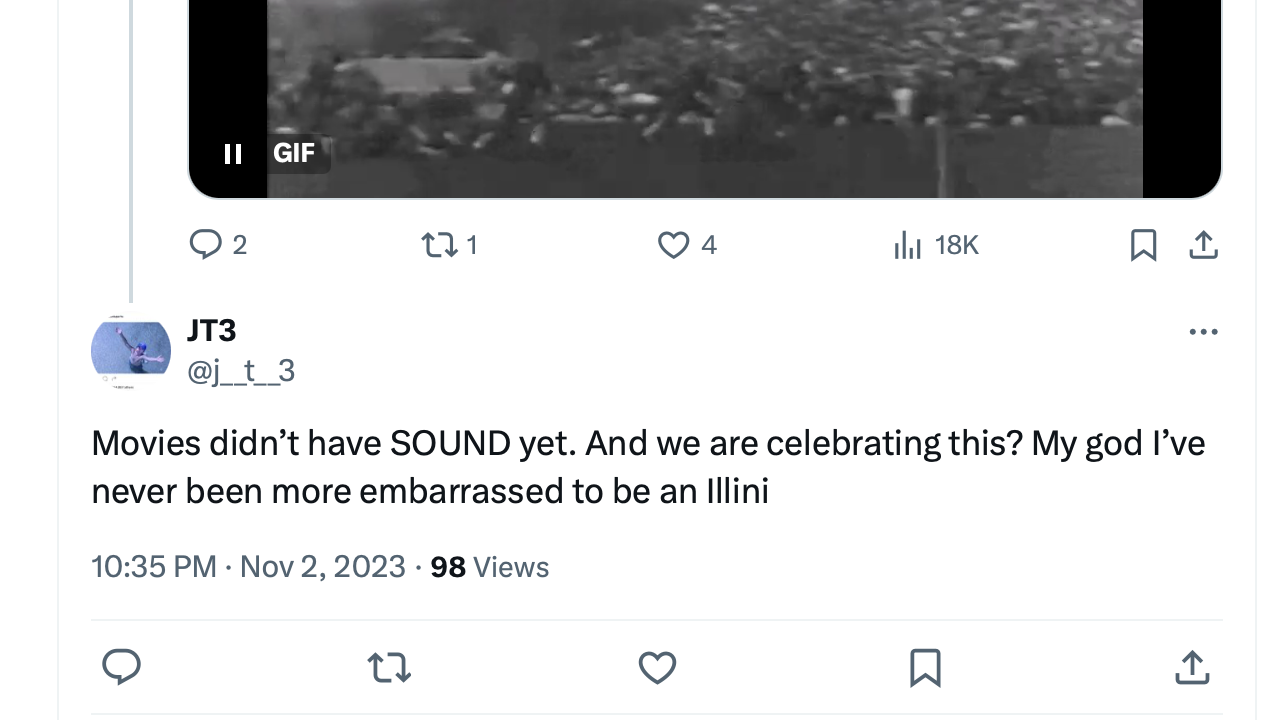
Yes, we're celebrating this. And I want you to understand why.
First off, you need to understand 1923. There was no AP Poll at the time, so often there were five or six teams claiming to be national champions. For that season, it is generally accepted that the two teams with claims to be co-champions were Michigan and Illinois. If you look at the Wikipedia entry for 1923, you see this:
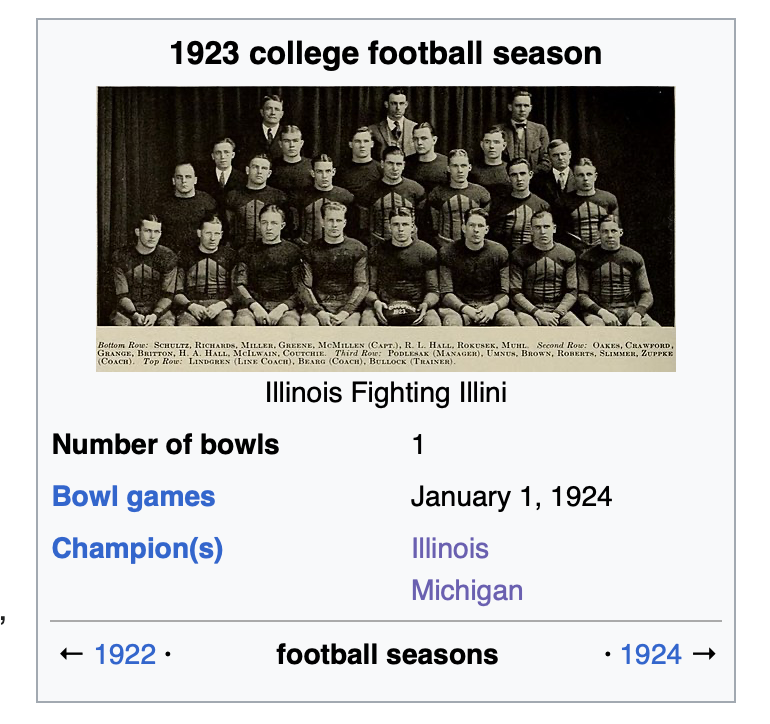
Illinois and Michigan were both 8-0 and were named champions by the majority of selectors. The reason they were both 8-0: they did not play that season. There were claims to be made based on common opponents (Michigan's claim is that Illinois won 9-0 at Ohio State and Michigan beat Ohio State 23-0 in Ann Arbor), but there was no head-to-head.
The Boand System, developed in 1930 and retroactively applied to the seasons from 1919 to 1929 to settle multiple claims to one national title, selected Illinois as the national champion for 1923. But both Michigan and Illinois have banners hanging for that year (and yes, Illinois claims some titles that the Boand didn't, like 1927 when the Boand System selected Yale). This is, obviously, no longer an issue now (besides, you know, UCF in 2017).
The point of telling you this: the 1924 game between Illinois and Michigan was a "let's prove this on the field" game. It was the third game for both (the seasons started in October back then). Illinois had beaten Nebraska and Butler and Michigan had beaten Miami (Ohio) and Michigan Agricultural (they became Michigan State in 1925).
So you need to picture the setup for this game. Michigan had not lost a football game since losing to Ohio State on October 22, 1921 (so nearly three years). The only thing that prevented them from claiming that they were going for a three-peat: they tied Vanderbilt in 1922. We had not lost since losing to Ohio State on November 25, 1922, so nearly two years. We laid claim to the 1923 title after going 8-0, and we were 2-0 entering this stadium dedication game, just like Michigan.
On top of that was the drama of Fielding Yost no longer being the Michigan head coach. If you look at Fielding Yost's bio, you'll see "Michigan head coach 1901-1923; 1925-1926." After the 1923 season, he moved up to Athletic Director and George Little took over as Michigan head coach for 1924. Seeing Red Grange humiliate Michigan caused Yost to un-retire and take over again in 1925. I'll let this snippet from the book "Champions Of The West" by Bruce Madej (linked in this MVictors Michigan article) take over from there. This is written from the perspective of the 1925 game after Yost had reinstated himself as head coach:
Just one year before, Coach George Little’s Wolverines had been humiliated by the Illini and their junior halfback, Harold “Red” Grange. So embarrassed was U-M athletic director Fielding Yost by Michigan’s performance that day, he decided to abandon his seat in the stands and return as head coach.
For 12 months, Yost schemed how to bridle Illinois’ Galloping Ghost. He replaced Michigan’s unsuccessful six-man line of 1924 with a seven-man front and a diamond-shaped secondary. Legendary Illini coach Bob Zuppke tried to counter the wily Yost by shifting Grange from his customary halfback post to quarterback.
Michigan did win that rematch against Illinois in 1925. But we're here to talk about the lead-up to October 18, 1924. I just wanted you to know the whole "Fielding Yost was so angry about Grange's 402 yards from scrimmage that day that he un-retired" angle first.
The other angle leading up to that game is what you've heard about all week - the Memorial Stadium Dedication. The reason it's called a "Dedication" and not "first game" is because Illinois had played some games on the field while construction was ongoing. Here's a shot (from the folder I forgot about) that shows the field ready for play while the stands are still under construction:
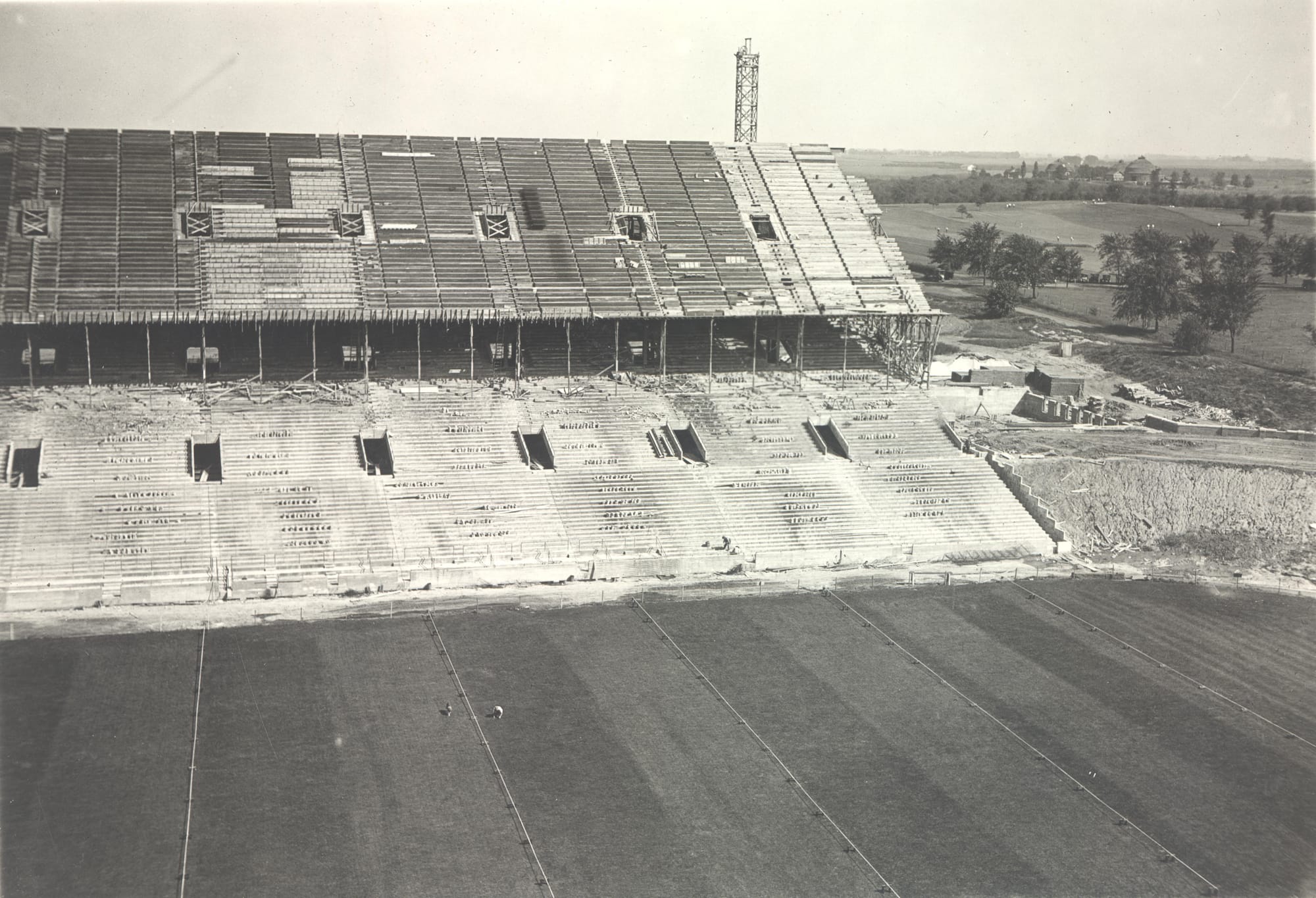
I believe they allowed fans in the lower levels for a few games in 1923 while the balconies were being built, but I can't find any photos in that folder showing fans in the stands. It doesn't really matter, I guess. The point is that they used the field for a few games in 1923 and then dedicated the stadium in 1924 once everything was complete.
And at that point, Red Grange had become a superstar. He was a First Team All American the previous season as a sophomore. People came from far and wide (most importantly, sportswriters like Grantland Rice) to see the Wheaton Iceman. So not only was this brand new stadium going up which fascinated the entire state of Illinois (remember, the Bears had only moved from Decatur to Chicago in 1922 and played at Cubs Park to small crowds so NFL football wasn't really a thing yet), here was this superstar that everyone wanted to see, guaranteeing that the dedication game would sell out.
I mean, think about what the roads were like, and what cars were like, in 1924. And then look at this photo from October 18, 1924:
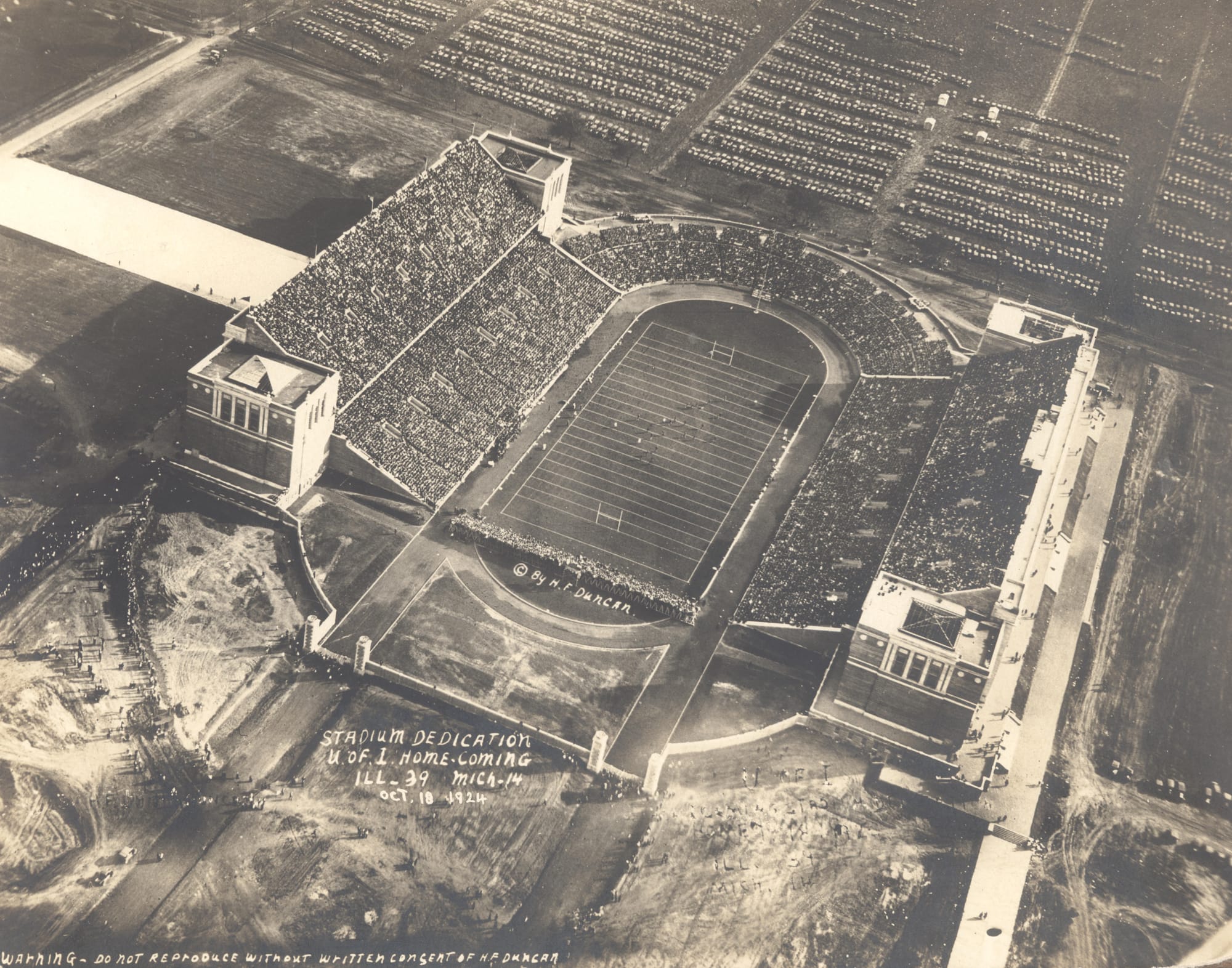
Just the thought of all of those cars making their way to Champaign to see this new stadium + this famous athlete + this "let's see who the real national champion was last year" game is just incredible to me. Every star aligning around one single game.
And then, in that game, Red Grange scores four times in the first 12 minutes. I've been through this on Twitter several times over the last year but one more time won't hurt:
Touchdowns allowed by Michigan in the entire 1921 season: 3
Touchdowns allowed by Michigan in the entire 1922 season: 1
Touchdowns allowed by Michigan in the entire 1923 season: 0
Touchdowns allowed by Michigan in the first 12 minutes of the 1924 game: 4
Four touchdowns in three seasons; four touchdowns in 12 minutes. I think you now understand what that author meant by "so embarrassed was Michigan Athletic Director Fielding Yost that he...".
This sent Red Grange hurtling towards superstardom. We've heard all of the quotes from Grantland Rice, but what about this one from famed journalist Damon Runyon?
"This man Red Grange of Illinois is three or four men and a horse rolled into one for football purposes. He is Jack Dempsey, Babe Ruth, Al Jolson, Paavo Nurmi and Man O' War."
(Paavo Nurmi was the most famous long distance runner at the time. He had just won five gold medals for Finland at the Paris Olympics that summer. Yes, I had to look that up.)
This is why I believe Red Grange to be the single greatest player in college football history. ESPN just did this list in 2020 and ranked him 6th overall (and Dick Butkus 8th, meaning Illinois was the only program with two of the top-10 players in college football history). When ESPN did a similar list in 2007 (with a different panel of experts), Red Grange was #1 on the list. He's not just some famous player from 100 years ago. He's the greatest of all time.
And it was known back then as well. In 1925, at the height of his fame, a Grange game set the record for the largest crowd to ever watch a sporting event in the United States. But it wasn't in Champaign. It was at Ohio State. And no, that's not just because Ohio State drew big crowds at the time. It was because of Red Grange. Reading this entire article from the Columbus Dispatch in 2014 is worth your time, but if you don't have that time, here's where it talks about the 1925 Illinois-Ohio State game:
Paid attendance was 84,295 - the largest crowd at that time to attend a sporting event in U.S. history. Those without tickets found other ways to get a look at Grange. A group of about 40 boys used a rope ladder to clear the stadium fences. When OSU announced that 10,000 general admission tickets would go on sale 30 minutes before kickoff, fans decided to arrive on Friday. By noon Saturday, five lines stretched from the stadium's southeastern corner to Neil Avenue, according to OSU football historian Jack Park.
Neither the Buckeyes nor the Illini could win the Big Ten title, but the game was secondary to being able to watch Grange wear his famous No. 77 college jersey for the last time.
Grange's legend had been secured the season before against Michigan when he scored four touchdowns in the first 12 minutes at the Memorial Stadium dedication game. He also ran for a fifth touchdown and threw for a sixth.
Ohio State fans had felt the sting of Grange's ability in 1923, when as a sophomore he scored Illinois' only touchdown on a 31-yard run in the fourth quarter of a 9-0 Illini win in Columbus.
After sitting out the 1924 game against Ohio State - Illinois still won 7-0 - Grange returned to Ohio Stadium for the second time in '25. The crowd reportedly stood every time he touched the ball in the Illini's 14-9 win.
The biggest touches came on defense, when Grange returned an interception 42 yards to the OSU 38-yard line to stop a fourth-quarter Buckeyes drive. Two minutes later, he intercepted another pass at midfield on the game's final play.
The next day, Grange signed a contract with Chicago owner/coach George Halas to play the remaining six games of the 1925 NFL season with the Bears.
I think I've made my point now. I think you understand the significance. Red Grange, in an era where points weren't scored and teams often punted as a way to advance the ball closer to the opponent's goal, literally changed the game of football with what I believe to be the single greatest individual performance in college football history. It happened 100 years ago tomorrow. And we will now celebrated it 100 years + 1 day later on October 19th, 2024. Against Michigan, the defending national champions (like 1924) with a new coach (like 1924).
Time for history to repeat itself.

Comments ()